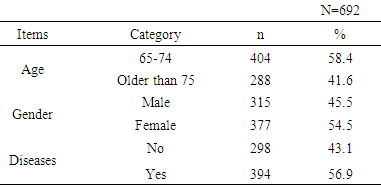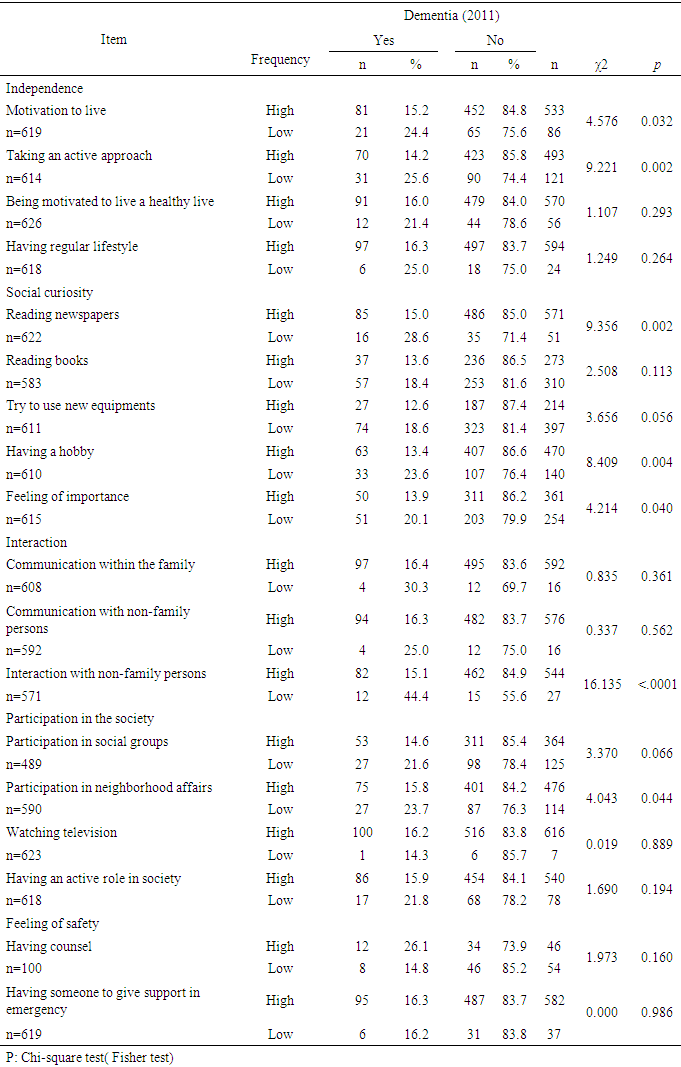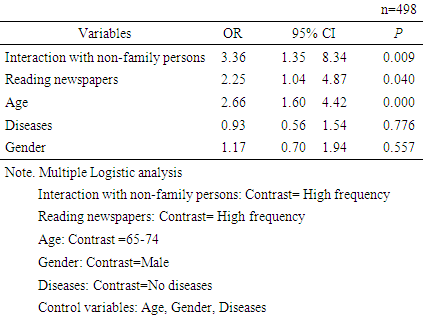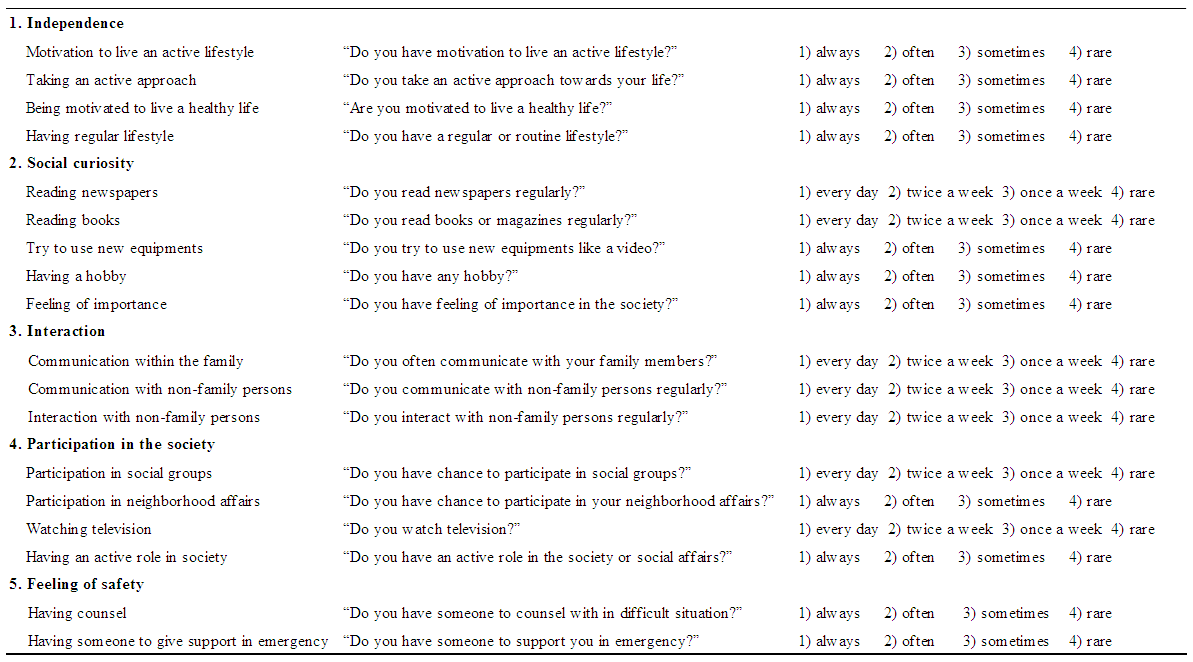-
Paper Information
- Next Paper
- Paper Submission
-
Journal Information
- About This Journal
- Editorial Board
- Current Issue
- Archive
- Author Guidelines
- Contact Us
Public Health Research
p-ISSN: 2167-7263 e-ISSN: 2167-7247
2018; 8(3): 60-67
doi:10.5923/j.phr.20180803.02

A Study of the Relationship between Social Interaction and Dementia in Older Adults
Cunyoen Kim1, Bailiang Wu2, Emiko Tanaka1, Kumi Watanabe1, Wencan Chen1, Sumio Ito3, Rika Okumura4, Taeko Watanabe5, Tokie Anme1
1Graduate School of Comprehensive Human Sciences, University of Tsukuba, Tsukuba, Ibaraki, Japan
2School of Social Development, Xihua University, Chengdu, China
3Board of Education Japan Tobisima, Aichi, Japan
4Department of Public Welfare, Tobisima, Aichi, Japan
5School of Nursing, Shukutoku University, Chiba, Japan
Correspondence to: Tokie Anme, Graduate School of Comprehensive Human Sciences, University of Tsukuba, Tsukuba, Ibaraki, Japan.
| Email: |  |
Copyright © 2018 The Author(s). Published by Scientific & Academic Publishing.
This work is licensed under the Creative Commons Attribution International License (CC BY).
http://creativecommons.org/licenses/by/4.0/

The population of dementia patients is increasing rapidly and an effective treatment is yet to be developed. Thus, the prevention of dementia is necessary and the role of social interaction in preventing dementia needs to be highlighted. The current study aims to clarify the relationship between social interaction and symptoms of dementia. This was a three-year longitudinal prospective cohort study called “Community Empowerment and Care for Well-being and Healthy Longevity,” using data from a project of a suburban area. The current study used the data from 2008 to 2011 and focused on older adults aged 60 years and above. The Index of Social Interaction was used to measure social interaction, and data on dementia was taken from the Health and Welfare Center of the local government. Demographic background was also considered. A chi-square test and a logistical regression analysis were used to examine the relationship between changes in social interaction and dementia. Participants in the study were 315 men (M = 73 years) and 377 women (M = 74 years) with healthy cognitive functioning participated in the current study. The chi-square test showed a positive association between social interaction and dementia risk. Furthermore, the multiple logistic analysis revealed that the items of “Interaction with non-family persons” (OR = 3.36) and “Reading newspapers” (OR = 2.25) were significantly related to symptoms of dementia after three years. The current study clarified the relationship between social interaction and the incidence of dementia symptoms. It indicated that participating in social interactions can prevent dementia.
Keywords: Social interaction, Dementia, Cognitive function, Longitudinal study
Cite this paper: Cunyoen Kim, Bailiang Wu, Emiko Tanaka, Kumi Watanabe, Wencan Chen, Sumio Ito, Rika Okumura, Taeko Watanabe, Tokie Anme, A Study of the Relationship between Social Interaction and Dementia in Older Adults, Public Health Research, Vol. 8 No. 3, 2018, pp. 60-67. doi: 10.5923/j.phr.20180803.02.
Article Outline
1. Introduction
- The challenge of an aging population, along with its expected attendant problem, is a growing concern across the world [1]. In 2012 in Japan, the number of older adults who were diagnosed with dementia was 4,620,000 and the number of older adults who had mild cognitive impairment was about 4,000,000. Therefore, it can be said that among adults over 65 years, 25% have dementia or are at a risk of dementia [2]. More and more people are beginning to recognize the importance of preventing dementia. This can be seen in group homes for dementia patients, which have become an important part of long-term care insurance [3]. Dementia is a degenerative disease that has a series of symptoms, such as cognitive decline, memory loss, perceptual problems, and apraxia [4]. According to previous studies, rapid cognitive decline in adults aged 65 years and above poses a higher risk of falling and earlier loss of autonomy [5]. Functional loss always leads to older adults needing to be taken care of. Although many previous studies have found some treatments for dementia, a complete cure is difficult to discover at present. For example, Mckeith’s study proved the efficacy of rivastigmine in dementia [6], but Viña’s review mentioned that in dementia such as Alzheimer’s disease therapeutics, only prevention makes sense [7]. Therefore, early prevention of dementia has been proposed to be the most important for older adults.Researchers have identified the risk factors for the prevention of dementia. These include hypertension, diabetes, and low metabolism [8, 9]. However, prior to these findings, cognitive decline was considered as a general risk to dementia, leading to cognitive impairment in the early stage of aging [10]. Epidemiologic studies have demonstrated that a reduction in social, physical, and cognitive activity is directly related to cognitive decline and dementia. For example, previous studies demonstrated that the people do physical activity at midlife at least twice a week would have reduced risk of dementia [11], and the participants in intervention group with better education behavior and physical activity could have higher score of ADAS-Cog [12]. Social activity contains many aspects (leisure activity, social engagement et al.) and previous studies have demonstrated its influence on the prevention of dementia [13]. Sandhu demonstrated that social relationships can influence physical and mental well-being in later life, while other studies have also shown an important relationship between social interaction and dementia [14, 15]. According to Pillai’s review, an active and socially integrated lifestyle in later life can protect against dementia [16].Although social interaction has proven to be an important factor in the status of dementia, few studies have used specific assessments to measure and assess social interaction in detail. Given that the exact relationship between social interaction and dementia is not clear, the current study aims to clarify this relationship.
2. Methods
2.1. Participants
- This was a three-year longitudinal prospective cohort study called “Community Empowerment and Care for Well-being and Healthy Longevity,” using data from a project of a suburban area. The project started in 1991 and all residents of the area participated in it every three years. The current study used the data from 2008 to 2011 and focused on older adults in order to clarify the relationship between social interaction and dementia. There were 692 cognitively healthy older adults who participated in 2008 and were followed until 2011. All of the participants were older than 65 years.
2.2. Measures
- In the current study used 3 main measures. Social interaction was evaluated using the Index of Social Interaction (ISI), a self-reported questionnaire developed for assessing social interaction of various types among Japanese people. The ISI contains 5 subscales, which consist of 18 items. Cronbach’s alpha for the subscales ranged from .78 to .81, and its validity and availability were also demonstrated [17]. The score on each item in the ISI was determined through the frequency indicated on the items (S1 Appendix). (1) the “Independence” subscale had 4 items (“Motivation to live an active lifestyle,” “Taking an active approach,” “Being motivated to live a healthy life,” and “Having a regular lifestyle”), (2) the “Social curiosity” subscale contained 5 items (“Reading newspapers,” “Reading books or magazines,” “Trying to use new equipment,” “Having a hobby,” and “Feeling of important”), (3) the “Interaction” subscale comprised three 3 items (“Communication within the family,” “Communication with non-family people,” and “Interactions with non-family people”. In this study, “Communication with” emphasizes “talking with”, and “Interaction with” emphasizes “visiting or meeting”), (4) the “Participation in society” subscale consisted of 4 items (“Participation in social groups,” “Participation in neighborhood affairs,” “Watching television,” and “Having an active role in society”), and (5) the “Feelings of safety” subscale was composed of 2 items (“Having counsel” and “Having someone to give support in an emergency”). The items in the “Independence,” “Social curiosity” and “Feelings of safety” subscales were scored by frequency (1 = rare, 2 = sometimes, 3 = often, 4 = always); likewise, the items in the “Interaction” and “Participation in society” subscales were scored by their frequency (1 = rare, 2 = once a week, 3 = twice a week, 4 = every day). The status of dementia was determined through a clinical diagnosis by medical doctors and an examination by professionals. Data on dementia was from the Health and Welfare Center in the local government (including AD, cardiovascular dementia, Lewy bodies, Parkinson, Higher Brain dysfunction).Age, gender, and status of diseases were obtained through a self-reported questionnaire. For the status of diseases, the question was “Are you hospitalized in the recent 1 year or do you have any diseases that need to be treated for more than 2 weeks continually?” Participants were then classified into a “Diseases group” or a “No diseases group” according to their answers (“yes” or “no”).
2.3. Data Analysis
- A chi-square test and multiple logistical regression analysis were used to examine the relationship between social interaction and status of dementia.The independent variable was the social interaction in baseline year (2008). The social interaction was considered “High frequency” if the selection was “always,” “every day,” “often,” or “twice a week” and was considered “Low frequency” if the selection was “sometimes,” “rare,” or “once a week.” The dependent variable was dementia status. If participants were diagnosed as “having dementia” or “having symptoms of dementia”, they were classified into the “dementia group.” Otherwise, they were assigned to the “normal group.” Given that previous studies have found that age, gender, and status of diseases might influence ability of daily living and dementia, age (60 to 74 years old = 0, older than 75 years old =1), gender (Man = 0, Woman = 1) and status of diseases (no = 0, yes = 1) were analyzed as control variables.All procedures were conducted using the Windows SAS 9.3 program, and p < 0.05 was used as the significance level for all statistical tests.
2.4. Ethical Considerations
- All participants signed a consent form and were informed that they could withdraw from the study after learning the objective and processes of this study. Additionally, data were collected anonymously and all personal information was protected by a personal identification system. This study was conducted after being approved by the ethics committee of the University of Tsukuba.
3. Results
- Table 1 shows that the study population was composed of 692 participants. There were 315 men with a mean age of 73 years (SD: ± 6.1) and 377 women with a mean age of 74 years (SD: ± 6.5). In addition, 394 participants (56.9%) presented with disease in baseline year. Table 2 shows the relationship between the characteristics of participants in baseline year and the incidence of dementia symptoms after three years. The incidence of dementia was associated with age (p < 0.05).
|
|
3.1. Chi-square Test for ISI and Dementia
- All The chi-square for the items “Motivation to live,” “Taking an active approach,” and symptoms of dementia of the Independence subscale were found to be significant after three years (χ2 = 4.58, p < 0.05; χ2 = 9.22, p < 0.01; Table 3). The items “Reading newspapers,” “Having a hobby,” and “Feeling of importance” of the Social Curiosity subscale, as well as symptoms of dementia were significant (χ2 = 9.36, p < 0.01; χ2 = 8.41, p < 0.01; χ2 = 4.21, p < 0.05). The item “Interaction with non-family persons” of the Interaction subscale and symptoms of dementia were significant (χ2 = 16.14, p < 0.01). Lastly, the item “Participation in neighborhood affairs” in the Participant in the society subscale and symptoms of dementia were significant (χ2 = 4.04, p < 0.05).
|
3.2. Multidimensional Analysis for ISI and Dementia
- After controlling for age, gender, and diseases, multiple logistic regression analysis was performed to predict symptoms of dementia after three years using the ISI items from 2008. As seen in Table 4, the items of “Interaction with non-family persons” (OR = 3.36) and “Reading newspapers” (OR = 2.25) were significantly related to symptoms of dementia after three years.
|
4. Discussion
- The current study found a relationship between social interaction and dementia through a community-based cohort study. None of the participants in the baseline year had dementia. However, after three years, symptoms of dementia were present in some older adults, especially those who had little social interaction. The results suggest that frequent social interaction is associated with a lower risk of dementia in older adults. In addition, the current study also examined the effects of older adults’ characteristics such as age, gender, and status of diseases on dementia status.In the current study, most of the participants belonged to the “High frequency group.” Most participants had positive social interactions in the studied suburban area. This finding suggests that, even though aging is inevitable, social interaction can be maintained by engaging in social environments. Previous cohort studies have shown that positive social interaction is related to the prevention of dementia [18]. For example, Mortimer’s trial demonstrated that better social interaction can maintain cognitive abilities while Bennett’s research indicated that an extended social network is beneficial for maintaining cognitive function. The current study also revealed that taking part in positive social interactions has a positive effect on preventing dementia [19, 20]. The current study showed that “independence” is beneficial for preventing dementia. The results of the chi-square tests suggest that “taking an active approach” is also beneficial for preventing dementia. Previous studies have suggested that, even for older adults who need care and have a positive mindset, the risk of dementia can be decreased [21]. Other studies have also demonstrated that either depression or anxiety is directly associated with cognition [22]. Taking an active approach means older adults have positive consideration and are likely to engage in social interaction. Thus, maintaining mental health and keeping a positive mindset are very important in old age.The current study also showed that “social curiosity” is beneficial for preventing dementia. The multiple logistic analysis indicated that participants who had a high frequency of reading newspapers were at a lower risk for dementia. Some studies have demonstrated that “reading newspapers” is not only a way to get information but also a mental activity [23, 13]. With the development of the Internet, more people have been getting information through devices such as their personal computers and smartphones. However, most older adults like to read and get information from newspapers. In addition, novel intellectual and cognitive stimulations have been pointed out as effective at reducing the risk of dementia in older adults [24]. For example, frequency of reading is related to cognitive function, and older adults with high frequency of reading had less cognitive decline [25]. The findings of the current study suggest that reading is beneficial for cognition. Although there was no significant result for the item of “Having a hobby” in multiple logistic analysis, the chi-square test indicated that having a hobby is related to dementia risk. Hobbies contain many types of activity, such as physical, social, and leisurely [26]. Several studies have indicated that intense physical activity, such as aerobics, sports, running, and bicycling, can reduce dementia risk [27, 28]. Other studies have demonstrated that leisurely activities such as board games, crafts, crossword puzzles, musical instruments, and card games can also prevent dementia [29]. It is likely that having hobbies that involve physical and cognitive activity is beneficial for the prevention of dementia.Many previous studies have demonstrated the importance of “Interaction” in the prevention of dementia. Fabrigoule’s and Carlson’s studies indicated that visiting and interacting with friends can reduce the risk of dementia [30, 24]. On the other hand, individuals who lived alone and had no friends or relatives had an increased risk of developing dementia [31]. After controlling for age, gender, and diseases, the current study found that the risk of dementia was high for older adults who rarely interact with non-family persons. This result supports the finding reviewed by Seeman that having connections with family, friends, and neighbors or engaging in social activities contributes to cognitive functioning [32].“Participation in society” was also correlated with dementia risk. For example, Cohen et al. (2006) demonstrated that social participation has a positive influence on mental health [33]. Helmer et al. and Saczynski et al. concluded that social disengagement is a risk factor for cognitive impairment among older adults [34, 35]. This finding confirms the results of previous studies showing that participating in society, such as participating in neighborhood affairs, is beneficial for cognitive functioning and is significantly associated with symptoms of dementia.In this study, there was no significant result for “Feeling safe.” Only 100 participants responded to the item of “Having counsel,” and there was no significant result; meanwhile, there was no significant relation between “Having someone to give support in emergency” and dementia risk. Many previous studies have explained the importance of social support in dementia [36]. However, another study indicated that the association between social support and dementia is not obvious [37]. When considering the local culture of this area, it is important to note that older adults are cautious in complaining about their troubles to others to maintain privacy. An advanced welfare system in this area and more evidence are necessary to examine whether “Feeling safe” is effective in preventing dementia.Additionally, a significant association between age and symptoms of dementia was found in the current study. Recent studies have demonstrated that dementia risk increases with age [38]. The current study also supported the view that aging is closely associated with the status of dementia. Regarding gender, some studies, such as Dannhauser’s study, have found that there was no significant association between gender and dementia risk [39]. The current study also suggests that the effect of gender is not apparent. Epidemiological studies have pointed out that diseases are related to cognitive decline [40]; likewise, some chronic diseases, such as diabetes, hypertension, and cardiovascular diseases, are important risk factors for dementia [41]. The analysis in the current study did not specify which diseases the participants had. This made it difficult to examine the effect of status of disease on the risk of dementia. Thus, the role of specified diseases will be examined further in a future study.There were three original aspects of the current study. First, the study used a longitudinal design that focused on the frequency of social interaction from a longitudinal perspective. Thus, it can add evidence to support the association between social interaction and dementia. Second, social interaction was measured in a multidimensional manner, which provided multiple aspects of stimulation from the social environment. The limitations of the study are as follows: First, only one suburban area was investigated. Second, some potential factors related to the risk of dementia, such as education level [42], specific diseases [8, 9], and alcohol consumption [43], were not carefully considered.The current study focused on the effects of social interaction on dementia symptoms and found that positive social interaction can provide protection from dementia. It indicated that engaging older adults in more active social interactions can effectively prevent dementia.
ACKNOWLEDGEMENTS
- We are deeply grateful to Mr. Kuno (Mayor of Tobishima), Mr. Hattori (Deputy Mayor), and all the research participants and staff. This research was supported by the Grants-in-Aid for Scientific Research (26590107, 26285130).
 Abstract
Abstract Reference
Reference Full-Text PDF
Full-Text PDF Full-text HTML
Full-text HTML



